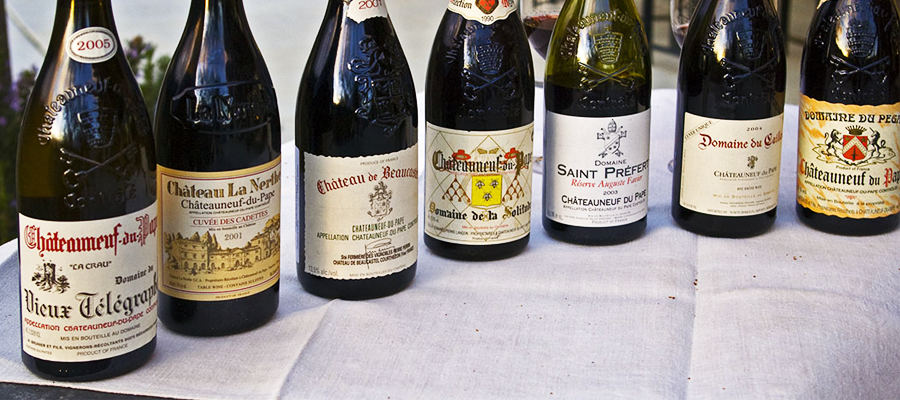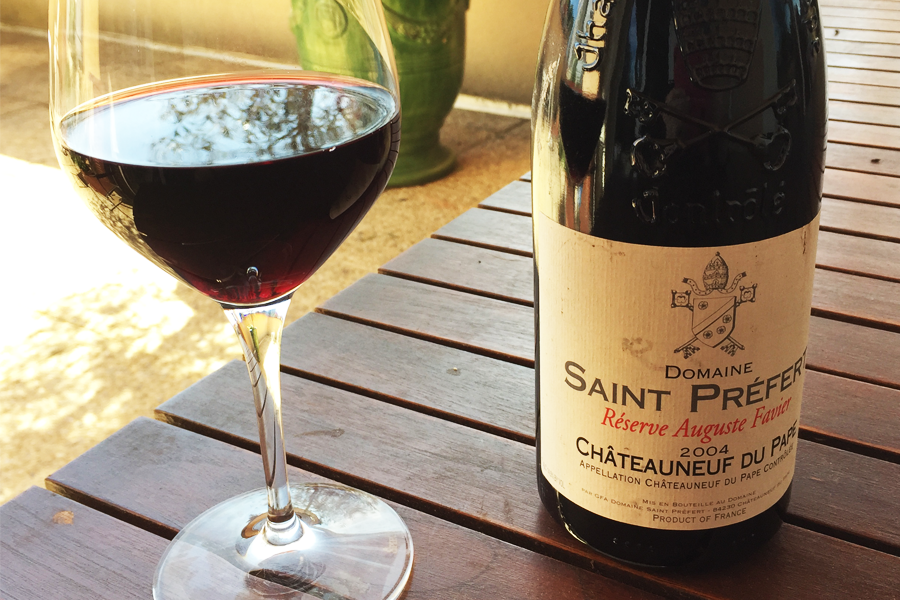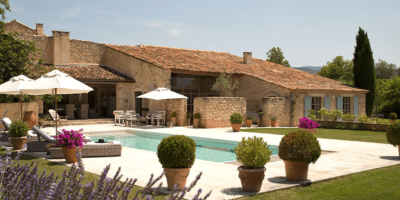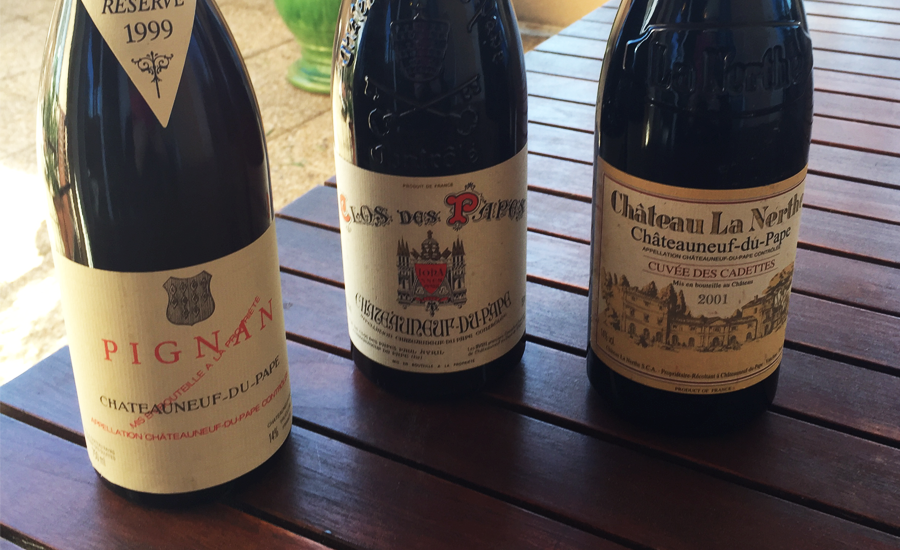The Printemps de Châteauneuf (Springtime in Châteauneuf) is a world class wine tasting week-end held early every April in this quiet southern Rhône village.
It is still a rather unknown event though it is the best public wine gathering in the south of France. 85-90 wineries –-a virtual who’s who in Châteauneuf-du-Pape—present their wines over a Saturday and Sunday. You can taste all week-end long for the outrageously low entrance fee of €10—about $11 US, or £8 per person. You can meet and talk to the winemakers, winery owners, and staff; you can purchase wine at winery prices. You can try an enormous variety of reds and the rare white Châteauneuf-du-Pape. (There is no rosé in the appellation, though some wineries do make it from grapes grown outside the appellation.) Winemakers are generous in providing many of their best cuvées for tasting.
You are welcome no matter what your level; you can just go and taste, or else deepen your knowledge of terroir, of the 13 grapes used in the wines, of the use of foudres vs new oak barrels, or of the winemaker’s opinion on de-stemming or not.
If your French is limited, not to worry. You can taste with the American sommelier wife of the owner of Bois de Boursan, or the Australian wife of the owner of Font de Michelle. Château de Beaucastel has a bi-lingual staff. Domaine de Pégau, Domaine Jean Royer, Château la Nerthe, André Brunel’s Domaine Les Cailloux and others have English speaking owners and/or staff pouring the wines. A lot of the young French winemakers travel in English speaking countries and welcome the opportunity to speak English.
Wine people in general are quite friendly and open which allows you make some terrific discoveries. A real highlight of the week-end is to find “hidden treasures.” Some of my recent finds include the terrific Natalie Reynaud, winemaker at her family’s Domaine l’Abbé Dîne. With vineyards near Château Rayas, Natalie makes exquisite white and red Châteauneuf, and top north Côtes du Rhône.

At Domaine Guiliani, Bernard and Aline Guiliani make Châteauneuf that starts at about €17 per bottle, and whose €6.50 Côtes du Rhône “Notes de Louis” is sold for €35 at a two-Michelin starred local restaurant. The “Notes de Louis” is a wine whose grapes are planted right next to the border of Châteauneuf so it is a terrific buy.
The atmosphere is friendly and I loved having the opportunity to see many of my Châteauneuf friends all in one place, especially after the quiet winter season. Wine lovers come from many parts of France and many foreign countries. As I waited in line for the doors to open, I was surprised to hear American English; a young American from San Diego drove up from Monaco for the day. I met other French, Americans, English, Swiss, Turks, and Belgians.
Each year the organizers, including famous oenologist Philippe Cambie, and affable and talented American sommelier Kelly MacAuliffe, along with local winemakers, plan several “ateliers” (tasting workshops); the cost is an additional €25-40 per person, and is well worth it. When the workshops are announced in February, I immediately register for all of them. Mr. François Audouze, who has the largest collection of old vintages in France led the tasting of “Old Vintages of Châteauneuf-du-Pape”; we had the enormous pleasure of tasting vintages from 1974 though 1998. He reiterated that “one shouldn’t judge an older wine, one needs to try to understand it” by keeping an open mind. Older wines definitely do not taste like fruit driven younger wines and two bottles of older wine, even from the same vintage and cuvée will taste different. François disagrees with Robert Parker regarding his theory on the life cycle of wines but he gave lots of credit to Parker, whose influence helped to improve the quality of local wines and the local economy as well.

A specialized workshop taylor-made for wine geeks was the “To de-stem or not” workshop. At least 90% of wines in Châteauneuf are de-stemmed, since winemakers want to produce wines that drink young, so it seems like a moot point. However some winemakers are rethinking this approach; after 2009, Isabel Ferrando of St. Préfert, one of Châteauneuf’s newest superstars, against advice of consultant Philippe Cambie, decided to leave some ripe stems in the fermentation since she thinks it will help her wines age better.
Irrefutably, and as always, the most popular atelier was the Culinary Workshop pairing Châteauneuf wines with foods. There were three whites and five reds paired precisely to match 8 dishes prepared by Chef Olivier Scola of Ze Bistro in Aix-en-Provence. Dominique Laporte, meilleur sommelier, commented on the matches, and winemakers were not the least bit shy about chiming in with their opinions. It seems to be the trend these days to do unorthodox pairings. Sometimes it worked beautifully, as in the case of the 2008 Domaine Pegau –a lighter vintage–paired with a slightly smoked cod with beets and meat “jus.” (Owner and winemaker Laurence Feraud loves this vintage with Thai food.) My favorite pairing was the 2010 red Vieux Donjon with the “Porc Noir de Bigorre” with mushrooms and small chunks of bacon.
Outside in the courtyard there is a high quality “French Style” Food Court with purveyors coming from all over France. Get a bottle of Châteauneuf and enjoy it for lunch with Cancale oysters on the half shell, cheese plates, eggs with Ventoux black truffles, grilled organic veal, “gratinée of Royans raviolis.” Then try some Carpentras strawberries and the exceptional chocolate from Peyrerol in Vaison-la-Romaine.
It is not too early to get on the mailing list for the 2017 tasting week-end. It will be held the week-end of April 8 and 9; registration generally starts in February.
When you are in Châteauneuf, be sure to stop by Vinadea for a tasting.
Article and photos : Sharon de Rham





